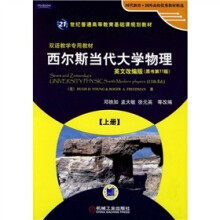Preface
1 PHYSICAL QUANTITIES AND VECTORS
1.1 The Nature of Physics
1.2 Idealized Models
1.3 Standards and Units
1.4 Uncertainty and Significant Figures
1.5 Vectors and Scalars
1.6 Vector Algebra
1.7 Unit Vectors and Component
Expression
Answer to Chapter Opening Question
Exercises
2 KINEMATICS
2.1 Particle Kinematics
2.2 Position Vector and Displacement
2.3 Velocity and Acceleration
2.4 Rectilinear Motion
2.5 Two Fundamental Problems in Kinematics
2.6 Relative Motion
Answer to Chapter Opening Question
Exercises
3 DYNAMICS
3.1 Particle Dynamics
3.2 Newton s Laws
3.3 Understanding Forces
3.4 Dynamics of Circular Motion
3.5 Non-inertial Frame and Inertial Forces
Answer to Chapter Opening Question
Exercises
4 WORK AND ENERGY
4.1 Kinetic Energy and Work
4.2 Calculating the Work
4.3 Path Independence of Conservative Forces
4.4 Potential Energy
4.5 Conservation of Mechanical Energy
4.6 Find the Conservative Force from Potential Energy
Answer to Chapter Opening Question
Exercises
5 MOMENTUM AND IMPULSE
5.1 Definition of Momentum
5.2 Conservation of Momentum
5.3 Impulse
5.4 Collisions
5.5 Center of Mass
5.6 Rocket Propulsion
5.7 Problem-Solving Strategy ISEE
Answer to Chapter Opening Question
Exercises
6 ROTATION OF RIGID BODIES
6.1 Angular Velocity and Acceleration
6.2 Rotation with Constant Angular Acceleration
6.3 Relating Linear and Angular Kinematics
6.4 Energy in Rotational Motion
6.5 Parallel-Axis Theorem
6.6 Moment of Inertia Calculations
Answer to Chapter Opening Question
Answers to Test Your Understanding
Questions
Exercises
7 DYNAMICS OF ROTATIONAL MOTION
7.1 Torque
7.2 Torque and Angular Acceleration fora Rigid Body
7.3 Rigid-Body Rotation About a MovingAxis
7.4 Work and Power in RotationalMotion
7.5 Angular Momentum
7.6 Conservation of Angular Momentum
7.7 Gyroscopes and Precession
Answer to Chapter Opening Question
Answers to Test Your Understanding
Questions
Exercises
8 PERIODIC MOTION
8.1 Describing Oscillation
8.2 Simple Harmonic Motion
8.3 Energy in Simple Harmonic Motion
8.4 Applications of Simple Harmonic Motion
8.5 The Simple Pendulum
8.6 The Physical Pendulum
8.7 Damped Oscillations
8.8 Forced Oscillations and Resonance
Answer to Chapter Opening Question
Answers to Test Your Understanding
Questions
Exercises
9 MECHANICAL WAVES
9.1 Types of Mechanical Waves
9.2 Periodic Waves
9.3 Mathematical Description of a Wave
9.4 Energy in Wave Motion
9.5 Wave Interference,Boundary Conditions and Superposition
9.6 Standing Waves on a String
9.7 Normal Modes of a String
9.8 Beats
9.9 The Doppler Effect
Answer to Chapter Opening Question
Answers to Test Your Understanding
Questions
Exercises
10 TEMPERATURE AND HEAT
10.1 Temperature and Thermal Equilibrium
10.2 Thermometers and Temperature Scales
10.3 Gas Thermometers and the Kelvin Scale
10.4 Quantity of Heat
10.5 Calorimetry and Phase Changes
10.6 Mechanisms of Heat Transfer
Answer to Chapter Opening Question
Answers to Test Your Understanding
Questions
Exercises
11 THERMAL PROPERTIES OF MATTER
11.1 Equations of State
11.2 Molecular Properties of Matter
11.3 Kinetic-Molecular Model of an Ideal Gas
11.4 Heat Capacities
11.5 Molecular Speeds
Answer to Chapter Opening Question
Answers to Test Your Understanding
Oestions
Exercises
12 THE FIRST LAW OF THERMODYNAMICS
12.1 Thermodynamic Systems
12.2 Work Done During Volume Changes
12.3 Paths Between Thermodynamic States
12.4 Internal Enerzv and the First Law of Thermodynamics
12.5 Kinds of Thermodynamic Processes
12.6 Internal Energy of an Ideal Gas
12.7 Heat Capacities of an Ideal Gas
12.8 Adiabatic Processes for an Ideal Gas
Answer to Chapter Opening Question
Answers to Test Your Understanding
Questions
Exercises
13 THE SECOND LAW OF THERMODYNAMICS
13.1 Directions of Thermodynamic Processes
13.2 Heat Engines
13.3 Refrigerators
13.4 The Second Law of Thermodynamics
13.5 The Carnot Cycle
13.6 Entropy
13.7 Microscopic Interpretation of Entropy
Answer to Chapter Opening Question
Answers to Test Your Understanding
Exercises
14 ELECTRIC CHARGE AND ELECTRIC FIELD
14.1 Electric Charge
14.2 Conductors,Insulators and Induced Charges
14.3 Coulomb s Law
14.4 Electric Field and Electric Forces
14.5 Electric Field Calculations
14.6 Electric Field Lines
14.7 Electric Dipoles
Answer to Chapter Opening Question
Answers to Test Your Understanding
Questions
Exercises
15 GAUSS S LAW
15.1 Charge and Electric Flux
15.2 Calculating Electric Flux
15.3 Gauss s Law
15.4 Applications of Gauss s Law
15.5 Charges on Conductors
Answer to Chapter Opening Question
Answers to Test Your Understanding
Questions
Exercises
16 ELECTRIC POTENTIAL
16.1 Electric Potential Energy
16.2 Electric Potential
16.3 Calculating Electric Potential
16.4 Equipotential Surfaces
16.5 Potential Gradient
Answer to Chapter Opening Question
Answers to Test Your Understanding
Questions
Exercises
17 CAPACITANCE AND DIELECTRICS
17. 1 Capacitors and Capacitance
17.2 Energy Storage in Capacitors and Electric-Field Energy
17.3 Dielectrics
17.4 Molecular Model of Induced Charge
17.5 Gauss s Law In Dielectrics
Answer to Chapter Opening Question
Answers to Test Your Understanding
Questions
Exercises
18 CURRENT, RESISTANCE AND ELECTROMOTIVE FORCE
18.1 Current
18.2 Resistivity
18.3 Resistance
18.4 Electromotive Force and Internal Resistance
18.5 Theory of Metallic Conduction
Answer to Chapter Opening Question
Answers to Test Your Understanding
Questions
Exercises
APPENDICES
Appendix A The International System of Units
Appendix B Useful Mathematical Relations
Appendix C The Greek Alphabet
Appendix D Periodic Table of the Elements
Appendix E Unit Conversion Factors
Appendix F Numerical Constants
Appendix G Answers to Exercises
教学支持信息表(填写本表,获取本书教辅资源)

 缺书网
缺书网 扫码进群
扫码进群





